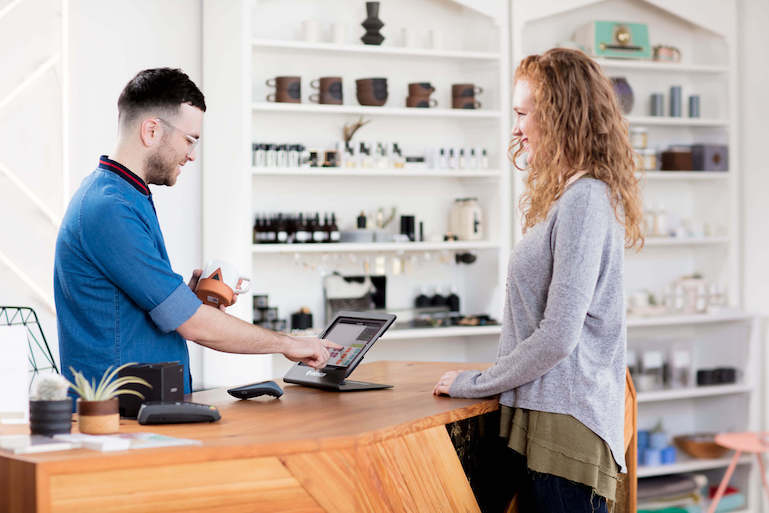
How to Use a Touch Screen Cash Register (6-Minute Guide)
Whether you’re a new business owner that’s never used a cash register before, or an experienced one that’s only used a traditional electronic cash register, moving into the world of touchscreen cash registers can be a little confusing.
But trust us, it’s worth it. If you invest a little time now to truly understand how your new register works, you’ll reap the rewards down the line with faster transaction speeds, more accurate employee tracking, simplified inventory management, and deep insights about the financial performance of your business.
To help you get up to speed with your new register so your small business can see these benefits as soon as possible, we put together this guide that will show you exactly how to use a touch screen cash register.
Let’s get started.
Set Up Your System
The first thing you’ll want to do is set up your new touch screen cash register. This is also the point in this guide where we want to clarify one detail. The retail, restaurant, and payments industries typically refer to touch screen cash registers as point of sale (POS) systems. To maintain consistency with these industries, we’re going to do the same.
If you decided to purchase a modern POS system that runs on an iPad or Android tablet, then the setup process should be pretty straightforward. You’ll want to connect your device to power, turn it on, and download your system’s register app from the App Store or Google Play Store. It’s also possible that your register app came preloaded on your tablet.
Before you can start using your register, you’ll want to login to your system’s back-office application and set up the rest of your point of sale system. This back-office software is where you’ll add inventory, configure tax rates, add new employees, review reports, and generally manage your business. In more modern systems, this application is typically accessed with a web browser on a laptop or desktop computer.
When the software side of your system is ready to go, and your tablet register is working, the next thing you’ll want to do is set up your hardware peripherals. For most businesses, this is going to include a cash drawer, credit card reader, and a receipt printer at a minimum. If you run a retail business, you might also have a barcode scanner. If you’re a grocer or sell items by weight, you may also have a scale that connects to your system.
Typically these devices connect to your device with either a cord or wirelessly over Bluetooth. Before opening your doors, we recommend running a few test transactions to ensure that all of your hardware and software is working correctly.
SEE ALSO: Need a Cash Register? There’s an App for That
Running Transactions
With your system set up, and your doors open, the next thing you’ll likely do is run a live transaction. Before you can do that, you’ll need to login to the register app on your tablet. Typically this involves entering a PIN code. Doing so allows you to tie all of the transactions and associated data (sales, returns, discounts) back to your account. This is a useful tool for helping you manage your employees, especially if you want a record of each employee’s register activity.
With that done, you’re ready to run transactions. To run a transaction, the first step is to enter the item that the customer is buying into the register. You can do that a few different ways. The easiest and fastest way is by scanning the barcode or UPC with a barcode scanner. However, if you don’t have one, or you run a restaurant (a situation where a scanner wouldn’t make sense), you‘ll need to either look for the item with the on-screen buttons or search for it using the on-screen keyboard.
Once you’ve added the item, or items, to the transaction, there are just a few more steps left. You’ll want to apply any discounts that might be valid to the customer’s transaction, and then select the customer’s tender type and collect payment. Some common tender types include cash, debit, credit, or smartphone payments like Apple Pay.
If your customer checked out with cash, you’ll want to hand them back any change they’re owed, and for all tender types, ask them if and how they’d like to receive their receipt. With most modern POS systems, you’ll be able to print or email the customer their receipt.
If the customer selects the email option, you’ll want to search for them in your system’s customer database. If they’re a new customer, you’ll need to add them, by collecting their email address. This is an important step because you can then add the customer to your email marketing list and send them promotions and other marketing emails designed to get them to buy from you again.
If the customer decides to check out with a credit card or debit card, you’ll either want to swipe it or insert it into your reader if it’s an EMV enabled card. The process is similar for running smartphone transactions. Normally the customer will just hold their phone over your reader and authenticate the transaction with their phone’s fingerprint reader or a PIN code. From there, you’ll want to follow the same receipt process as you would with a cash transaction.
Closing Your Shift
After a busy day spent running transactions for customers, there are a few things you’ll want to do before you turn off the lights and head home for the night. It all starts with closing your shift. Normally this is a quick process. Just navigate through your register app’s interface until you find the right button. Tap it and you’ll begin the process of closing your shift.
On most modern POS systems, closing a shift will require you to enter the amount of cash remaining in the cash drawer. This ensures accurate recordkeeping day to day. Once you enter the cash amount into the register app, go ahead and close the shift.
From here you’ll want to print out a Z Report. This report gives you a summary of the entire shift. It’ll also let you know if the drawer amount you just entered is over or under the expected amount. If you have less cash than you expected, it could be a sign that you have an employee theft problem, so it’s definitely something we recommend looking into.
In addition to the register opening and closing amount, the Z Report will show you other high-level information that will help you understand the day’s activity. Here are a few examples:
- Sales by Tender – the day’s sales total broken down by tender types like cash and credit.
- Returns – the day’s returns total broken down by tender types like cash and credit.
- Discounts – the day’s discounts total broken down by tender types like cash and credit.
- Drops – the amount of cash removed from the register to be deposited to a safe or bank.
- Pay Ins – the amount of cash you added to the drawer during the day (e.g., you added a roll of quarters for change).
Once you’ve printed out your Z Report, the very last thing you’ll want to do is clock out of the register app to end your shift for the day. Time to head home for some much-needed rest and relaxation.
There you have it, everything you need to know about how to use a touch screen register, otherwise known as a point of sale system. If you’re in the market for a POS system and are looking for one that packs powerful features into an easy to use and affordable package, learn more about ShopKeep, the #-1 rated POS system.
Want to try ShopKeep for yourself?
Just answer a few easy questions.
Need help finding the right point of sale?
Just complete the form. We’ll call you right back to explain how ShopKeep can work for you.
Hit the ground running.Sprinting, in fact!
Read our free, comprehensive guide, Small Business 101, to learn all you need to know about starting a thriving business.

